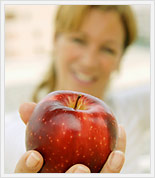 |
Already a member? Secure Login
|

- Ideal Weight Calculator
- Waist-to-Hip Ratio Calculator
- BMI Calculator
- Frame Size Calculator
- Target Heart Rate Calculator

- Good Fast Food
- Recipe Makeovers
- Meal Plans
- Nutrient Facts
- Food Label Claims
- Estimating Serving Sizes



Energy Density of Foods
QUESTION:
I saw a sign in the produce section of the supermarket that said that eating an apple before each meal can help with weight loss. Is this true?
I saw a sign in the produce section of the supermarket that said that eating an apple before each meal can help with weight loss. Is this true?
ANSWER:
 Well, actually it can! Although eating an apple prior to a meal doesn't actually change the way the calories in the meal are digested or utilized, it can actually fill you up so that you may eat less during the meal. Apples are high in water and fiber - components that fill you up and help you feel satisfied. Other food choices that help you feel full with few calories are items such as broth-based soups, salads, fresh fruits and vegetables.
Well, actually it can! Although eating an apple prior to a meal doesn't actually change the way the calories in the meal are digested or utilized, it can actually fill you up so that you may eat less during the meal. Apples are high in water and fiber - components that fill you up and help you feel satisfied. Other food choices that help you feel full with few calories are items such as broth-based soups, salads, fresh fruits and vegetables.For instance, past research has shown that by eating a large portion of a low-energy, dense salad (filled with veggies and low-fat or non-fat dressing) prior to a meal resulted in the participants eating fewer calories in the meal. Another study showed that participants who ate soup twice a day for a snack lost more weight than a group of participants who ate dry snack foods such as crackers and chips. In other words, increasing fullness while adding few calories reduces the total calories consumed. This concept of energy density, also known as caloric density of foods, can be defined as "the number of calories in a given weight of food". This can be calculated by using the following equation:
Energy Density = calories per serving / weight of serving in grams
Barbara Rolls, Ph.D., has done extensive research in this area and has termed this concept of caloric density "Volumetrics". She has recommended that a large portion of our food choices should have energy densities of less than 1 (i.e., fresh fruits, vegetables, low-fat dairy) or 2 (i.e., beans, fish, poultry, etc.), and that food choices above an energy density of 2 (i.e., oils, desserts, french fries, etc.) should be used sparingly. Not only do these food choices follow the principles set out by the latest 2005 Dietary Guidelines for Americans, it makes sense from a nutritional standpoint also, because low-energy-dense foods tend to be high in nutrients. So eating this way is the best way to get your nutrients and to lose weight too!
Does that mean you should be calculating the energy density of all the foods you eat? Not necessarily. If you have questions about where a certain food falls in the spectrum of energy density, then doing the calculations can give you some good feedback. However, it's good to simply be aware that fresh foods that are unprocessed or minimally processed with little or no added fat will tend to have low-energy-densities. Think high fiber, high water content, high nutrient content, and unprocessed, and you'll be on the right track. So, if you like apples, then be reassured that an apple or two a day can help keep the pounds away!
| Related Articles: |
 |
Our expert, Dr. Sharon E. Griffin, holds a B.S., M.S., and Ph.D. in the areas of exercise science/physiology. She also holds a second M.S. degree in Nutrition and is a licensed nutritionist and an ACSM certified health and fitness instructor.
© 2024 MyFoodDiary.com. All Rights Reserved.